Happy Holidays from Aquaveo!
By aquaveo on December 23, 2020Here at Aquaveo we'd like to wish you a great holiday season! We will see you in 2021!
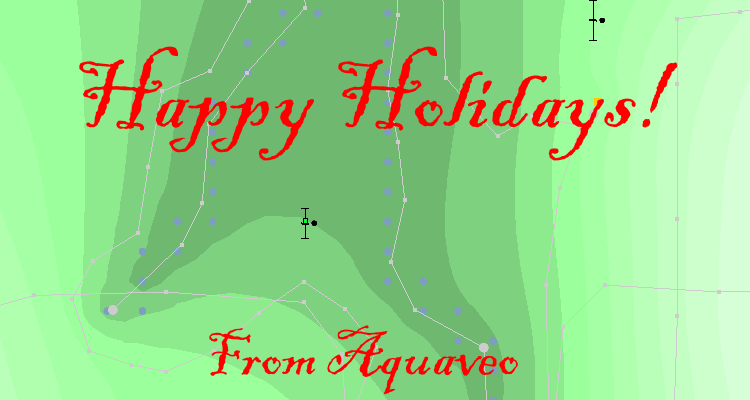
Here at Aquaveo we'd like to wish you a great holiday season! We will see you in 2021!

With the release of GMS10.5 Beta, a few changes were made to how some selection functions work to make selecting objects in a project easier. A couple of the existing functionalities were improved and a new selection tool was added. This article discusses some of these changes.
The Invert Selection tool existed in earlier versions of GMS. The tool switches which objects are selected so that the objects that were selected are no longer selected and any object that was not selected is now selected. In earlier versions, this tool could be launched from the Edit menu. Starting in GMS 10.5 beta, the command to invert the selection can be found by right-clicking in the Graphics Window after selecting one or more objects.
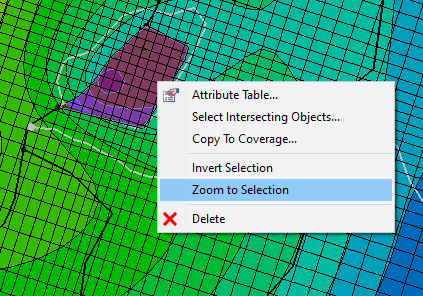
Zoom to Selection is a new tool introduced in GMS 10.5 beta. This tool works by selecting an object in the Graphics Window. Then right-click the object to find the Zoom to Selection command. Using this command will zoom in on the selected object so that it fills the Graphics Window.
To go along with the change of having the Invert Selection and Zoom to Selection commands as part of the right-click menu for map tools, a change was made to what happens when the right-click menu was invoked. Previously, invoking the right-click command with a map tool by clicking in an empty part of the Graphics Window caused any selected objects to become unselected. In GMS 10.5 beta, map objects are not unselected when right-clicking in an empty spot of the Graphics Window. Instead, the new right-click menu will appear.
Previously, when an object was selected and you held down the Shift key, if you selected an empty part of the Graphics Window, your selected object would become unselected. In GMS 10.5 beta, objects no longer become unselected.
These are a few of the changes to selecting objects in GMS 10.5 beta. Try out the GMS 10.5 beta today.
GMS, SMS, and WMS (collectively known as XMS) all make use of numerical models for the final simulation run. These numerical models include MODFLOW, ADCIRC, SRH-2D, GSSHA, HEC-RAS, etc. These numerical models are not developed by Aquaveo, but the XMS software does provide an interface for using these models. This article will discuss more about how the XMS software integrates with these numerical models.
XMS will allow you to import all of the starting data and define all the parameters for a numerical model simulation. After the project has been built in XMS, XMS will export all of the files needed for the model run. XMS will then access the numeric model executable and launch the numerical model to run your simulation.
If the numerical model fails to run, there sometimes can be an issue with the numerical model executable. Typically, you will receive a warning message stating the model executable can’t be found. When this happens there are two ways to resolve the conflict.
The first is to click the browse button on the warning dialog and browse to the location of the model executable. Select the model executable and simulation will start running. In most cases, the model executables are located in a folder called models located in the locations where the XMS software has been installed.
The second method is to make certain the path to the model executable location has been correctly in XMS. This is done by going the Preferences dialog (use the Edit | Preferences command). In the Preferences dialog, there is a tab call either Files or File Locations. On the Files tab is a list of the available numerical models and where XMS is accessing that executable for the model. From here, you can change the file path to point to the correct location of the model executable.
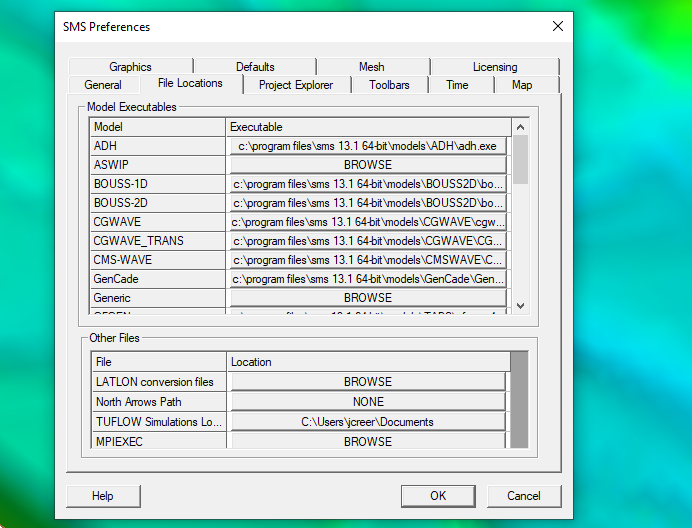
Often when the model executable cannot be found the cause is one of a few common issues. One is that the path location was not correctly set when XMS was installed. Another is that the numerical model was not installed correctly. And another is that you may have been using a custom installation of the numerical model software with the model executable in a location where XMS is not looking.
Also note that some numerical models require multiple executables. Often this is a pre-processor that has its own executable. Make certain that the file path is correct for all executables used by the numerical model.
Making certain the correct model executable can be found by XMS can make running your model simulation a lot easier. Check out all the available numerical models availing in XMS today!
With the release of SMS 13.1 beta, a significant number of tools have been added for working with cross sections. These tools allow you to have more control over importing cross section databases and how you can work with cross sections in SMS.
Earlier versions of SMS have allowed you to import a cross section database and provided the cross section and centerline coverages. This lets you create a basic 1D model in SMS. SMS 13.1 expands on this functionality.
The new cross section tools in SMS 13.1 include:
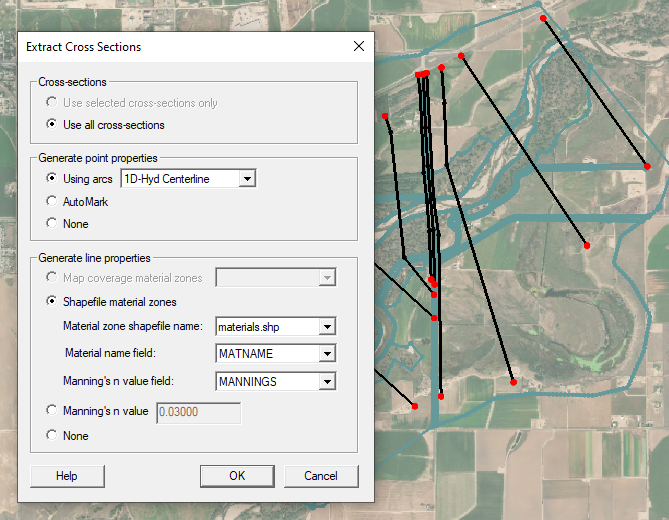
When working with these new tools in SMS 13.1 beta, there are a couple items to keep in mind.
The first is that when interpolating cross sections, check for overlapping cross sections after the interpolation process is complete. If you trim your cross sections before interpolating your cross sections, you may prevent some overlapping.
The next item to keep in mind is that before converting cross sections to a TIN, it is recommended that you manually clean up the cross sections. Cross sections that have overlapping sections, unnecessary segments, or poor location can cause errors in the TIN.
Finally, converting a shapefile to a centerline coverage can be slow. It is recommended to convert the shapefile to an area property coverage first. After converting the shapefile to an area property coverage, clean up the arcs on the area property coverage then convert the area property coverage to a centerline coverage.
Tutorial for using the new cross sections tools will be made available in the coming months. Until then,our technical support team can help provide guidance in using these new tools. Try out the new cross section tools in SMS 13.1 beta today!
For any groundwater modeling project, having the correct units is essential in creating a valid project. When working with GMS, make certain that the project units are correct. To help you with having the correct units, here are some tips for working with units in GMS.
Before importing data into GMS, check units of the data. Ideally, all of your data will be using the same units. So, for example, if you are working in meters then make certain all the data you will be importing is in meters.
It is recommended that you convert the data into the correct units before importing it into GMS. GMS will not change the units of your data during the import process. That said, it is recommended to check the units of imported data to make certain the data imported correctly. This is done by checking the data’s projection.
Please note that GMS also does not perform unit conversions when writing values to input files for models, such as MODFLOW or MT3DMS packages, but writes the values to input files as they are shown in their respective package dialogs.
Instead of converting the units of your data before importing it into GMS, you can convert some data inside GMS. GMS does not do automatic conversion of units for data. So if all of your data is in meters and you bring in one set of data that is in feet, GMS will not automatically convert the data from feet to meters.
Instead, after importing the data, you have two options for converting the data into the correct units.
The first of these options is to reproject the data. This is done by right-clicking on the data in the Project Explorer and selecting the Reproject command. This option can quickly change the units of the data in GMS.
The other option is to create a new dataset with the correct units. This is done using the Data Calculator. In the Data Calculator, you would select the dataset with the wrong units then enter the equation to convert the dataset units into the calculator. Once the new dataset is calculated, make certain that dataset is being used in the project and not the older dataset.
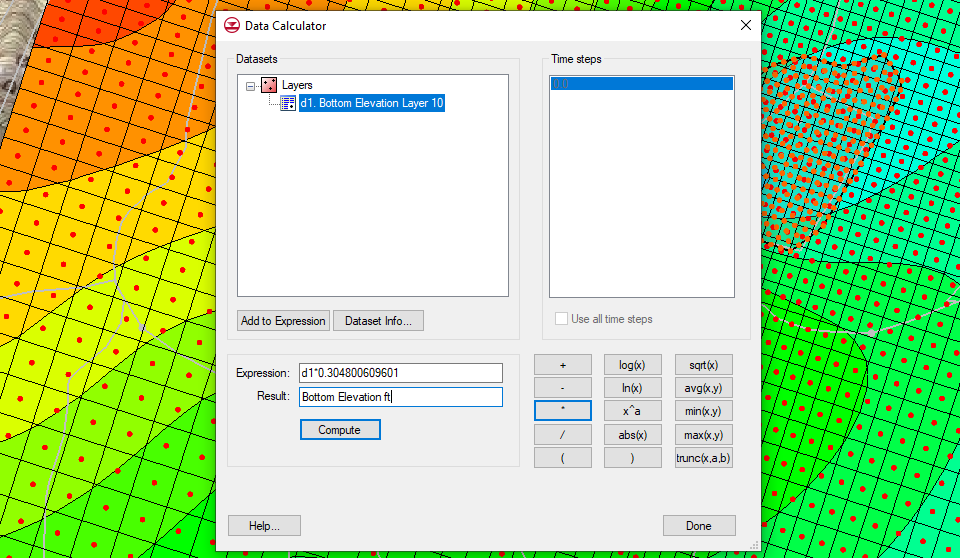
After completing your model and running it, it is recommended that you check the units of the output data. In most cases, the units in the output data will be correct. If the units are not correct, this often indicates an issue with the input values of the model. GMS does not change the units of data during the model run.
Having correct units will make your groundwater modeling in GMS run smoother. Check out GMS today!
WMS provides a lot of ways to interpolate data from one module to another. Since geometric objects may not line up exactly, values often need to be interpolated from one object to another. Common interpolation methods involve interpolating DEM and TIN elevation to a grid or mesh. However, a lesser known function is interpolating data to the feature objects on a map coverage.
Elevation values for a TIN orDEM can be interpolated to feature objects. Doing this will add the elevation values to the feature objects, specifically to points and vertices. To interpolate to feature objects:
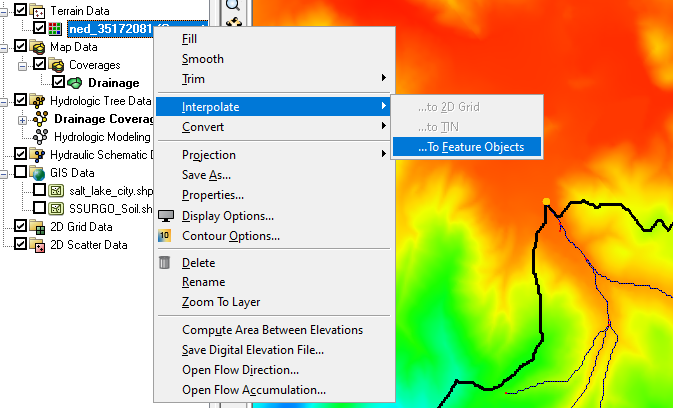
The elevation values on the TIN or DEM will then be added to the features objects of the active map coverage. This process will only interpolate values to the active map coverage. Inactive map coverages will not be affected and only one map coverage can receive elevation values this way.
Interpolating to feature objects uses linear interpolation. If a point or vertex lies between a DEM or TIN elevation point, the interpolation method will estimate the closest approximate value. Elevation values will not be interpolated to feature objects that are outside of the DEM or TIN area.
Typically, interpolated to feature objects is done when you have manually added features objects without designating elevation during the digitization process. It can also be used in cases where the elevation values appear inaccurate and need to be changed to match a new set of elevation values. It may also be useful after importing map data that is missing elevation data.
Try out interpolating to feature objects in WMS today!
In SMS, after spending time creating the perfect arc, polygon, or series of points on a map coverage, you may find that you need that feature object added to other coverages. Recreating the same feature object manually could be too time consuming. Fortunately, with the release of SMS 13.1 beta, there is now the Copy to Coverage command.
The Copy to Coverage command allows copying selected feature objects from one map coverage to another. To use the Copy to Coverage command:
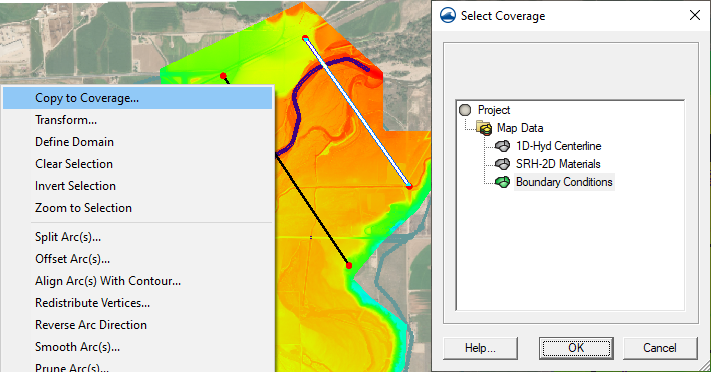
When the feature object has been copied, attributes (boundary condition types, materials values, etc.) assigned to the object on the original coverage will need to be reassigned if the new coverage is of the same coverage type. Currently, feature object attributes cannot be preserved when copying to a coverage of the same type.
The Copy to Coverage command is most useful when you have a coverage with a lot of feature objects, such as those imported from a shapefile, but you are only needing one or two of those feature objects copied to a new coverage. For example, have a mesh generator coverage with arcs that would work well for boundary conditions, you could select and copy just the arcs that you intend you use as boundary condition arcs to a boundary conditions coverage. This is a faster process than duplicating the entire coverage, changing the coverage type, and deleting unnecessary objects.
You can copy multiple objects at once, by using the shift key to select multiple objects of the same type. In SMS 13.1, you can also use the universal Select Objects tool to select multiple feature objects of different types which can also then be copied to a new coverage.
Try out the Copy to Coverage command in SMS 13.1 beta today!
Do you have several MODFLOW simulations that you have created using GMS and would like to set all of the simulations to run overnight or over a weekend? Running a batch of MODFLOW simulations can be accomplished using a batch file. A batch file allows using the Command Prompt to run several commands in a sequence of actions. Therefore, a batch file can be used to run multiple MODFLOW simulations.
To do this, you will need to create a batch file that references the MODFLOW executable and the name file for each MODFLOW simulation you intend to run. To create a batch file, you can create the file from scratch, or you can use GMS to generate a batch file for a single simulation which can then be edited to add additional simulations.
When using GMS to create a single simulation batch file, do the following:
Among the simulation files, you will have a *.bat file. To use this file to run multiple MODFLOW simulations, do the following:
Once the simulations have run to completion, you can load the results into GMS by creating a GMS MODFLOW results file (or MFR file) for each simulation. The file name of the MFR file should match the MODFLOW name file.The format for an MFR file can be found by examining an existing GMS MODFLOW solution set.
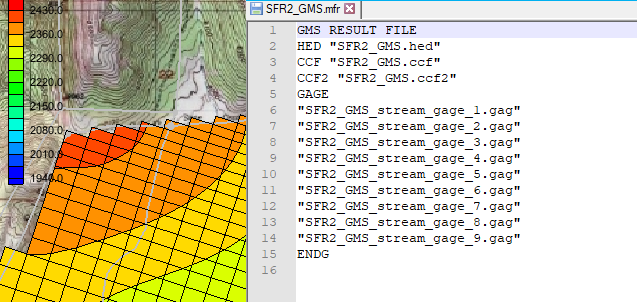
It is recommended that you use the GMS model check for each simulation and resolve any issues found before including the simulation in the batch run. However, if the simulation does include a problem, it will not stop the following simulations from running. In this way, MODFLOW can be run for multiple GMS projects.
Try creating a batch run for multiple MODFLOW simulations using GMS today!
WMS makes creating hydrologic models easier by providing the Hydrologic Modeling Wizard. This tool steps you through the process of developing a hydrologic model. Each step completes one of the elements needed for a complete hydrologic model. To make using this tool easier and more productive, here are a couple tips for using the Hydrologic Modeling Wizard in WMS.
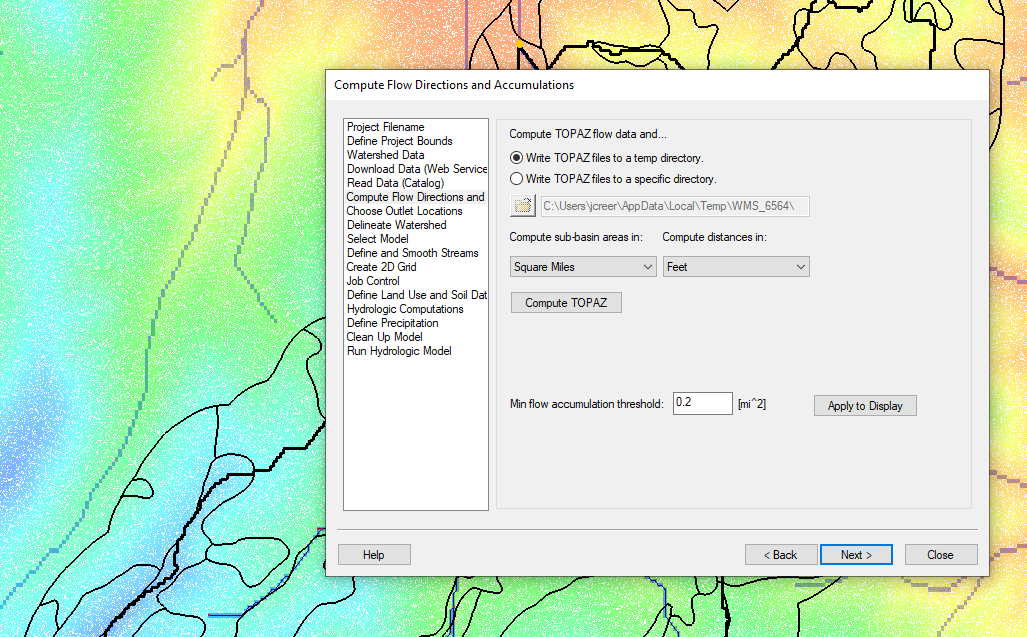
The first tip is that the Hydrologic Modeling Wizard is modular in nature. This means the wizard does not need to be closed in order to continue working in the WMS interface, unlike many other windows and dialogues in WMS. The wizard can be put to the side of your screen to let you work with other tools in WMS. Often this is necessary to adjust arcs in the Graphics Window or to import additional data. Once you are done with what you need to do, you can return to the Hydrologic Modeling Wizard.
It should also be noted that the Hydrologic Modeling Wizard keeps track of changes as you work in it. So if you should happen to close it, you can reopen it and get back to where you left off. However, you should make certain to save your WMS project before closing WMS in order to save changes made in the wizard to your WMS project.
Another tip is that you do not need to complete all of the steps in order. Some steps can be completed out of order. For example you may want to set the model you are using before completing earlier steps. Or, more often, you may have completed earlier steps outside of the wizard, letting you skip to later steps. That said, there are some steps that will not work unless a previous step has been completed.
Also note that you can always go back to earlier steps. Note that when doing this some steps that follow may have to be completed again.
The Hydrologic Modeling Wizard is a powerful tool to help you create hydrologic models faster. The tips presented here can also be applied to the other modeling wizards in WMS. Try out the Hydrologic Modeling Wizard in WMS today!
Feature objects in SMS resemble the objects in shapefiles in many ways. Shapefiles are a file format used by many GIS applications. Starting in SMS 13.1, feature objects in SMS can be directly exported into shapefiles.
SMS 13.1 allows points, arcs, and polygons to be exported from a specified map coverage to shapefile. This done by doing the following:
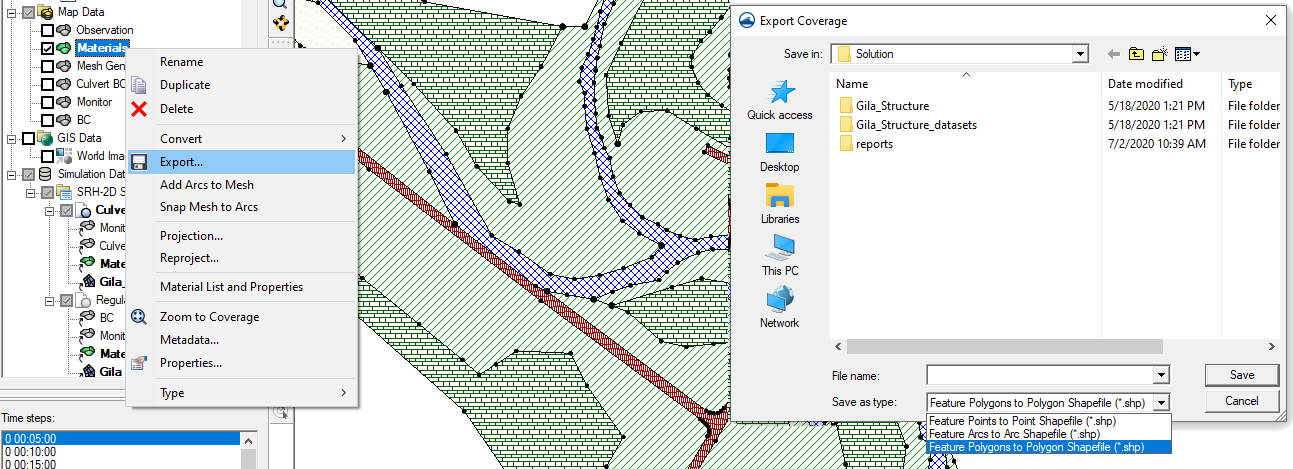
Be certain to select the correct file type when exporting feature objects. Only the matching feature object type will be exported to a shapefile from the coverage. SMS allows you to export feature points as a points shapefile, feature arcs as a line shapefile, and feature polygons as a polygon shapefile.
It is also recommended to review the feature objects on the coverage before exporting to a shapefile. Individual feature objects cannot be exported at this time, therefore, it is advisable to remove any unwanted features before exported. This can be done by duplicating the map coverage and then deleting the unwanted feature objects.
If desired, you can import the exported shapefile into SMS. The shapefile will appear in the GIS module and can then be compared with the feature objects on original map coverage. Otherwise the shapefile is ready to be imported into the desired application.
It should be noted that not all data on map coverages can be exported into a shapefile format. Some data, such as boundary conditions attributes or coverage specific settings, may not end being exported.
Try out creating shapefiles from feature objects in the SMS 13.1 beta today!